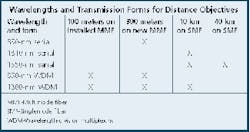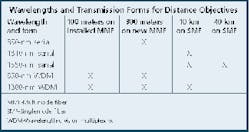IEEE's aggressive schedule addresses applications for a new high-bandwidth multimode fiber.
Patrick McLaughlin
The IEEE 802.3ae Task Force, part of the Institute of Electrical and Electronics Engineers (IEEE-New York City) 802.3 Work Group, has been working on a 10-Gigabit Ethernet standard for approximately two years. And for the most part, that work had gone on fairly quietly, at least as far as the premises-cabling industry was concerned. But lately, as the IEEE's 10 Gigabit Ethernet gets closer to being an actual, deployable protocol, premises-cabling professionals have begun to pay keen attention to it.
The topic was a significant point of discussion at BICSI's (Tampa, FL) Fall Conference in August. In his presentation entitled "10 Gigabit Ethernet-Convergence of LAN and WAN," Chris DiMinico, director of network systems technology with Cable Design Technologies' Leominster, MA, operation, commented that "the ink is not yet dry on the Gigabit Ethernet standard, and we are already talking about 10 gigabit." Other presentations at the conference also touched on the subject, including "Gigabit Ethernet for High-Speed Networking," by John Kamino, RCDD, with Lucent Technologies (Murray Hill, NJ), and a panel discussion on fiber in the premises.
DiMinico's point about the development of 10 Gigabit Ethernet coming quickly on the heels of the IEEE's fiber- specific Gigabit Ethernet standard (published in the summer of 1998) raises a point about why 10 Gigabit Ethernet is becoming such a topic of conversation in the premises-networking industry. Many corporate networking professionals use 100-Mbit/sec switched Ethernet to the desktop, which requires a gigabit-speed backbone. Many of those who deploy this protocol to the desktop will, in all likelihood, eventually migrate to gigabit-to-the-desk networking. And just as a switched 100-Mbit/sec-to-the-desk setup requires a gigabit backbone, a switched gigabit-to-the-desk setup will require a higher-speed 10-Gbit backbone. So, any network manager currently deploying a gigabit backbone has to keep an eye on this higher-speed protocol to successfully plan future upgrades.
Tasks of the Task Force
The 802.3ae Task Force is sticking to its original target date of March 2002 for publication of the standard. "That is a fairly aggressive timeline, but the Task Force is making a real effort to keep to it," says Peter Pondillo, senior market development engineer at Corning Inc. (Corning, NY). The group has already made strides in its effort. It has also defined objectives to support several media and distances, including at least 100 meters on installed multimode fiber, and at least 300 meters on multimode fiber.
What that means to the end user is that in an existing cabling plant, multimode fiber will support 10 Gigabit Ethernet for at least 100 meters. But to be assured of at least 300-meter transmission distance, new fiber will be necessary-and not just any new fiber.
A new multimode fiber
Manufacturers of optical fiber have been at work developing 50-micron multimode fiber that is optimized for 10-Gbit-speed serial transmission (as opposed to wavelength-division multiplexing or parallel transmission). Lucent has had such a fiber, available under the brand name LazrSPEED, commercially available since January. Pondillo says that a 50-micron 10-Gbit-optimized fiber from Corning is "developed and tested. It is not yet commercially available, but is expected to be available in early 2001."
Of note is that the IEEE is only recognizing 50-micron fiber-not 62.5-micron-as a medium to support 10 Gigabit Ethernet for at least 300 meters. "Why 50-micron? Because it is a better fiber," says Corning's Pondillo. "The smaller core equates to fewer transmission modes, which results in higher bandwidth. A 50-micron fiber allows longer link lengths at a higher bandwidth than a 62.5-micron fiber allows."
Achieving higher bandwidth
Just how much bandwidth is necessary for a 50-micron fiber to transmit 10 billion bits per second? "The exact minimum bandwidth necessary to transmit 10 Gbits/sec in serial form depends on a number of parameters," says Paul Kolesar, distinguished member of Lucent's technical staff. "Lucent, together with several other companies, proposed to IEEE 802.3ae a complete set of parameters that define an 850-nm VCSEL [vertical-cavity surface-emitting laser]-based system, consisting of a laser transmitter, receiver, and fiber, that will operate to 300 meters over the new multimode fiber. In this proposal, the fiber 'laser bandwidth' is 2,000 MHz-km."
Asked to explain how this "new" fiber differs from the 50-micron fiber that has been available for years, Kolesar says, "In addition to the standard overfilled bandwidth measurement, the fiber bandwidth is measured using a new method that reveals much more information about the fiber's modal-propagation properties, which are important to support laser-based transmission systems.
"Unlike light-emitting diodes, which tend to overfill the fiber by exciting all mode groups, laser sources-which are necessary for high-speed transmission-produce excitation that can become concentrated in just a fraction of the mode groups. Because of this concentration, each mode group must be well-behaved because it may carry a significant portion of the signal. Such careful control is not needed with overfilled excitation because each mode group carries only a small fraction of the power, and therefore can be masked by the other mode groups."
Kolesar continues, "The new measurement technique we use allows us to see the behavior of each mode group. Using this measurement technique, we have refined our manufacturing process to produce fibers that meet the stringent requirements necessary to support 10-Gbit transmission to 300 meters."
Both Kolesar and Pondillo agree that although what goes on inside the new multimode fiber is different from what goes on inside existing fibers, externally there is very little difference. In particular, installers will not have to learn new termination techniques for the new fibers. "The new fiber has the same installation characteristics as other multimode fibers," Pondillo says.
Kolesar comments, "Although the precision of the core's graded-index profile far exceeds that of 'typical' 50-micron fibers, these new fibers are geometrically the same. They are installed and terminated with connectors in the same way."
In addition to the two distance objectives for multimode fiber, the IEEE 802.3ae Task Force is working toward three distance measurements for singlemode fiber: 2, 10, and 40 km minimum. Achieving some of these distances likely will necessitate transmission forms other than serial.
Transmission techniques
"Serial, wavelength-division multiplexing [WDM], and parallel are the three most popular transmission techniques," says Lucent's Kolesar. They can be used separately or in combination. For example, it is possible to combine WDM and parallel, but this is not very practical for cost reasons.
He describes each technique as follows:
- Serial is the simplest transmission method, and is used exclusively for the most common applications to date. For example, the serial method is employed by Ethernet, Asynchronous Transfer Mode, Fiber Distributed Data Interface, Token Ring, and Fibre Channel. Going in one direction, the serial approach simply transmits the information using a laser and one receiver over one fiber, using one wavelength. Therefore, the information is conveyed on one channel running at the stated data rate (in this example, 10 Gbits/sec). This scheme's simplicity translates into the least-complex optics, and leads to lower cost. The LazrSPEED fiber was developed specifically to support this method to enable the lowest-cost solution for the end user.
- Wavelength-division multiplexing divides the information into multiple channels, each operating on a different wave-length or color of light. For example, the WDM solutions proposed to IEEE 802.3ab for 10 Gigabit Ethernet use four wavelengths. Each channel operates at one-fourth of that data rate, with some additional overhead due to the specific digital encoding employed, allowing the use of lower-speed integrated-circuit (IC) technology. Such systems trade lower-speed and lower-power ICs for more-complex optics. In the 10-Gbit example, in one direction, the system uses four lasers, four receivers, a wavelength combiner, and a splitter. It operates over a single fiber.
- Parallel transmission is another multiplexing scheme that divides the data into multiple channels, each one conveyed on a separate fiber. For example, in a 4-channel system, the user would deploy four lasers, four receivers, and four fibers in each direction. Like WDM, this approach uses lower-power and lower-speed ICs, and more- complex optics than those used in serial transmission. It trades the complexity of WDM's wavelength-selective components for more fiber and array connectors. This approach can make sense today, because it is available. But its cost-competitive position is quickly lost when link lengths exceed approximately 30 meters.
The IEEE group responsible for the 10-Gigabit Ethernet standard was scheduled to meet again in September, although that meeting had not yet taken place at the time of this writing. Cable Design Technologies' DiMinico, who acts as the liaison between the IEEE and the Telecommunications Industry Associa-tion (TIA-Arlington, VA) TR-42 Engineering Committee, stated in August that the September meeting would include discussion of a first draft standard with key proposals, including the physical layer. He also indicated that the group is considering specifying an 850-nm serial option, and WDM options at 850 and 1300 nm for the 300-meter link lengths.

